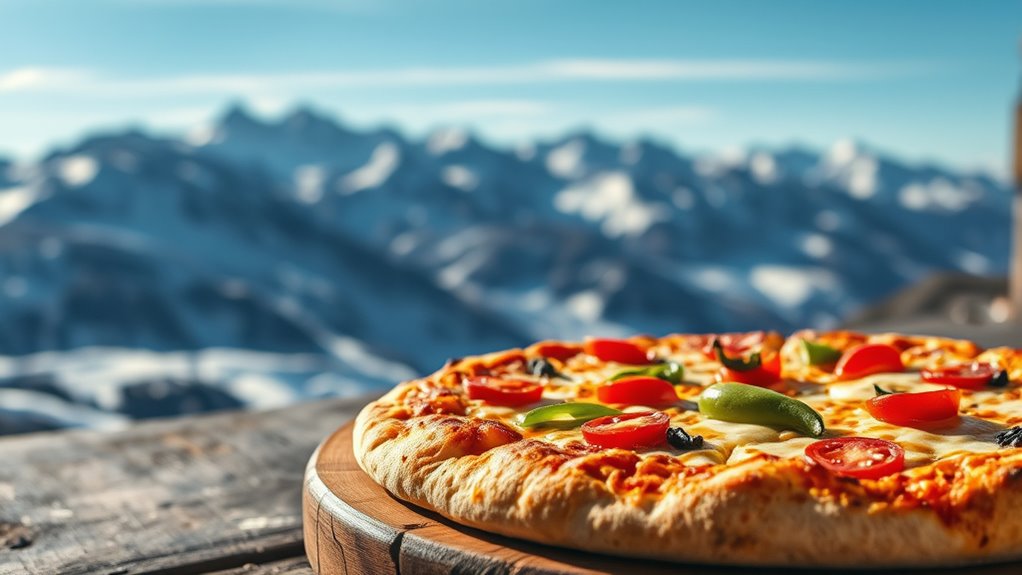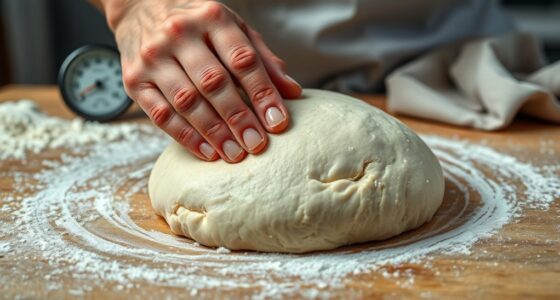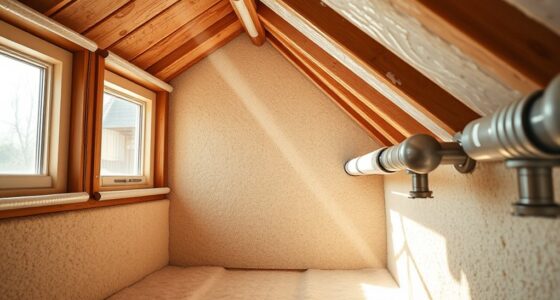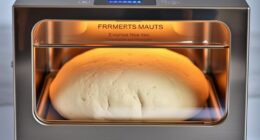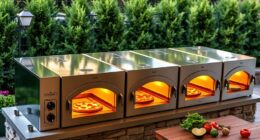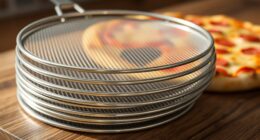To master high-altitude pizza, you need to adjust your dough by increasing water and flour, reducing yeast, and giving it proper rest. Tweak oven temps slightly higher but shorten baking time to prevent dryness or burning. Pay attention to toppings, pre-cooking moist ingredients, and controlling moisture levels. Troubleshoot issues like over-rising or underbaking with systematic tweaks. Continued efforts will help you perfect your pizza at any elevation.
Key Takeaways
- Adjust dough hydration, flour, and yeast to counteract rapid moisture loss and faster fermentation at high altitude.
- Increase oven temperature slightly and reduce baking time to prevent over-baking and achieve optimal crust texture.
- Pre-cook or drain high-moisture toppings to avoid sogginess and promote even baking.
- Monitor and control dough proofing by reducing yeast and incorporating rest periods for better elasticity.
- Troubleshoot issues systematically: modify ingredients, timing, and oven settings for consistent high-altitude pizza results.
Adjusting Flour and Hydration Levels
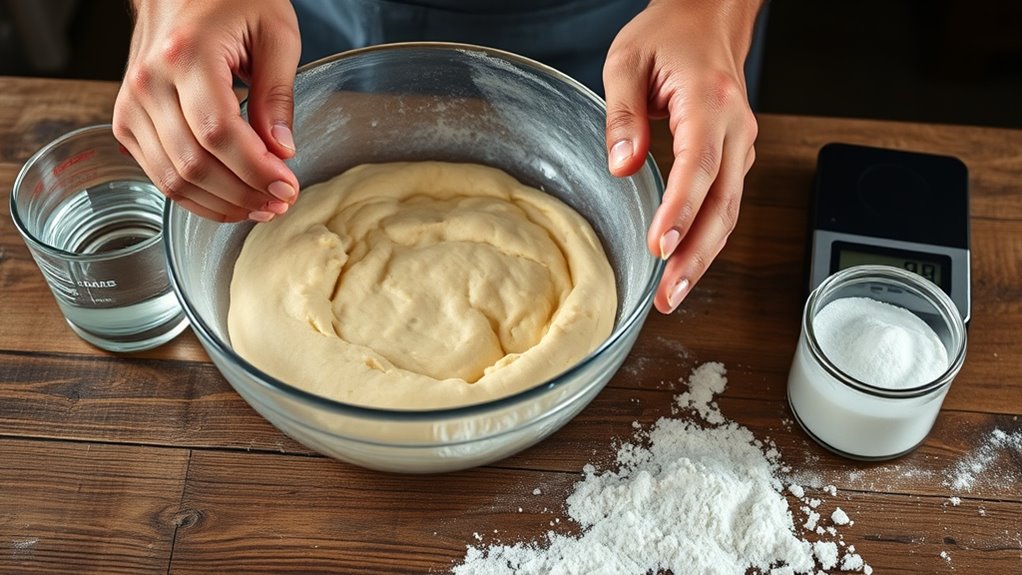
At high altitudes, the lower air pressure and humidity can affect how your dough behaves, so adjusting your flour and hydration levels is essential. Less humidity means your dough can dry out quickly, leading to crust texture variations like a tougher or denser crust. To counteract this, increase your hydration slightly—adding a bit more water helps maintain elasticity and prevents overly tough crusts. Using a bit more flour can also stabilize the dough, compensating for altitude-induced flavor shifts that may make your crust taste drier or less flavorful. Additionally, color accuracy, which influences the appearance of your baked goods, can be affected by altitude-related environmental factors. Remember, every altitude is different, so small adjustments and testing are key to achieving the perfect balance. Proper flour and hydration adjustments will help you create a tender, flavorful crust with consistent texture at high elevations.
Modifying Yeast Quantities and Fermentation Time
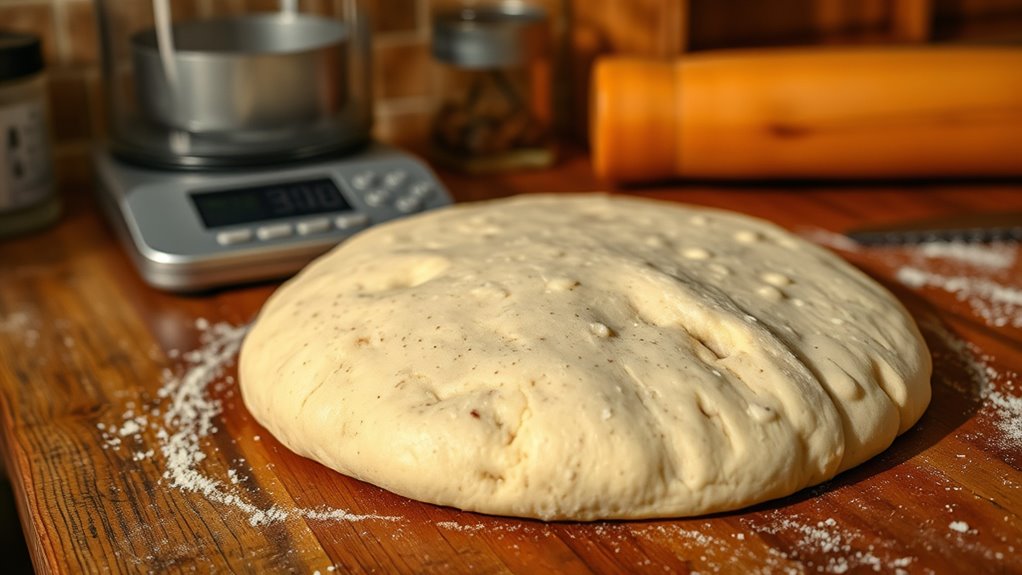
Since high altitudes can speed up fermentation and yeast activity, you’ll need to modify the amount of yeast you use accordingly. Reducing yeast quantity helps prevent over-fermentation and preserves dough structure. You might try decreasing the yeast by about 25% to 50%, depending on your altitude. Additionally, monitor fermentation temperature closely; cooler environments slow yeast activation, giving you more control over rise times. To manage this, keep your dough in a slightly warmer spot if fermentation proceeds too quickly or refrigerate it to slow down activity. These adjustments ensure your dough develops the right flavor and texture without over-proofing. Remember, fine-tuning yeast quantities and fermentation temperature is key to achieving perfect pizza crusts at high elevations. Incorporating vertical storage solutions can also help organize your baking supplies efficiently and keep your workspace clutter-free, making the process more enjoyable.
Tweaking Oven Temperature and Baking Time
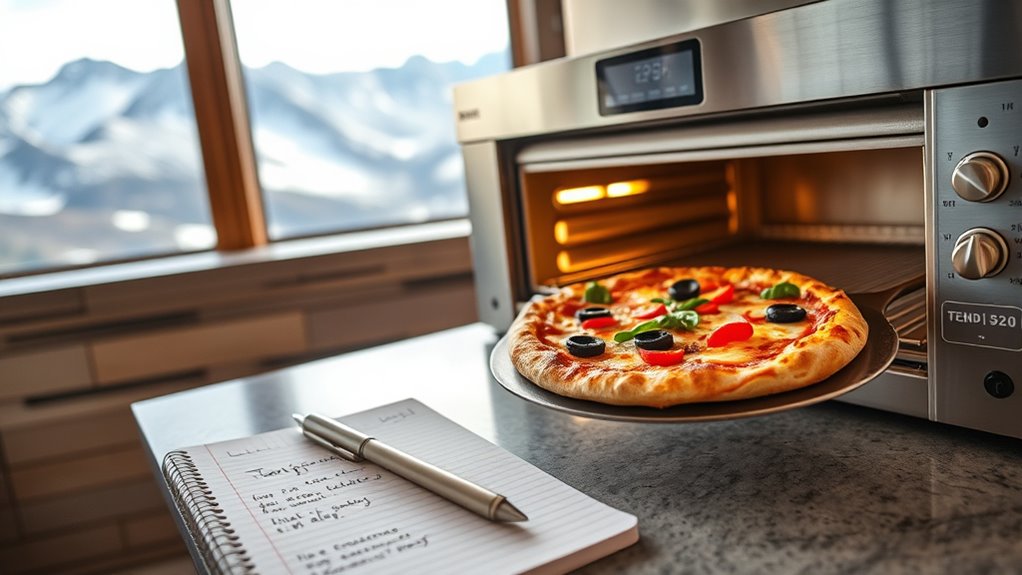
Adjusting your oven temperature and baking time is essential for achieving perfect pizza crusts at high altitudes. Higher elevations often cause dough to cook faster, so increasing the oven temperature slightly can promote better gluten development, resulting in a sturdier crust. You might need to reduce baking time to prevent over-baking or burning. An elevated temperature encourages the Maillard reaction, enhancing flavor development in your crust and toppings. Keep a close eye on your pizza as it bakes, since small adjustments can make a big difference. Proper tweaking ensures your crust is crispy yet tender, with ideal gluten structure. Additionally, understanding best beaches can inspire relaxing breaks after baking sessions. Experimenting with these settings will help you find the ideal balance for flavor enhancement and perfect texture, even at high altitudes.
Altering Dough Mixing and Kneading Techniques
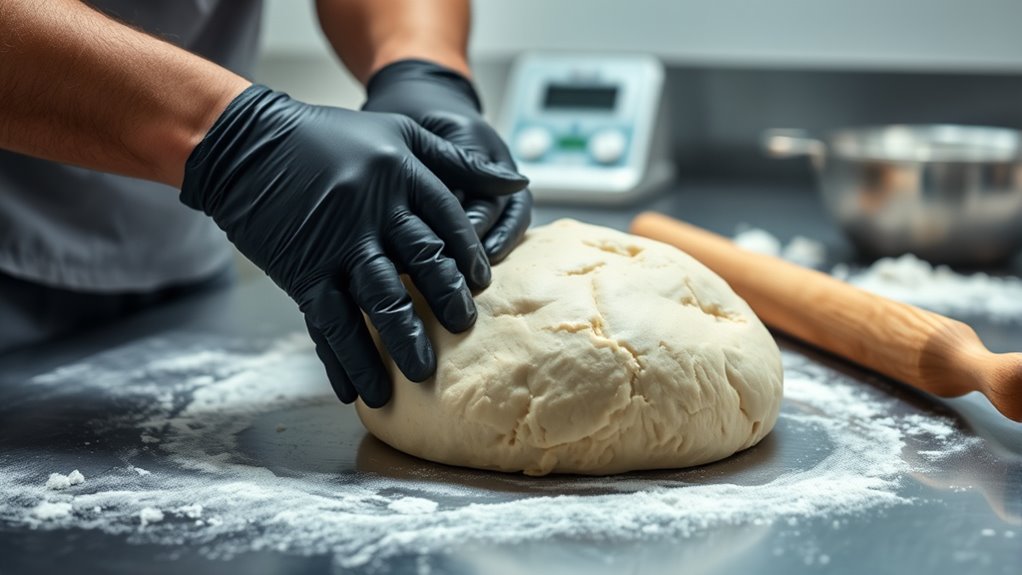
When making pizza dough at high altitudes, altering your mixing and kneading techniques can considerably improve the final crust. Proper kneading impacts dough texture, ensuring it’s elastic and smooth without becoming overworked. To adapt, consider these tips:
- Mix ingredients just until combined to prevent overdeveloping gluten.
- Use a gentle folding method during mixing to maintain dough tenderness.
- Knead for a shorter time, around 8-10 minutes, to avoid toughening the crust.
- Incorporate a rest period to allow gluten relaxation, improving elasticity.
- Adjust hydration levels slightly higher to counteract rapid moisture evaporation at altitude.
- Utilizing expert voice actors and immersive soundscapes in your process can help you better understand and visualize optimal techniques.
Managing Toppings and Moisture Content
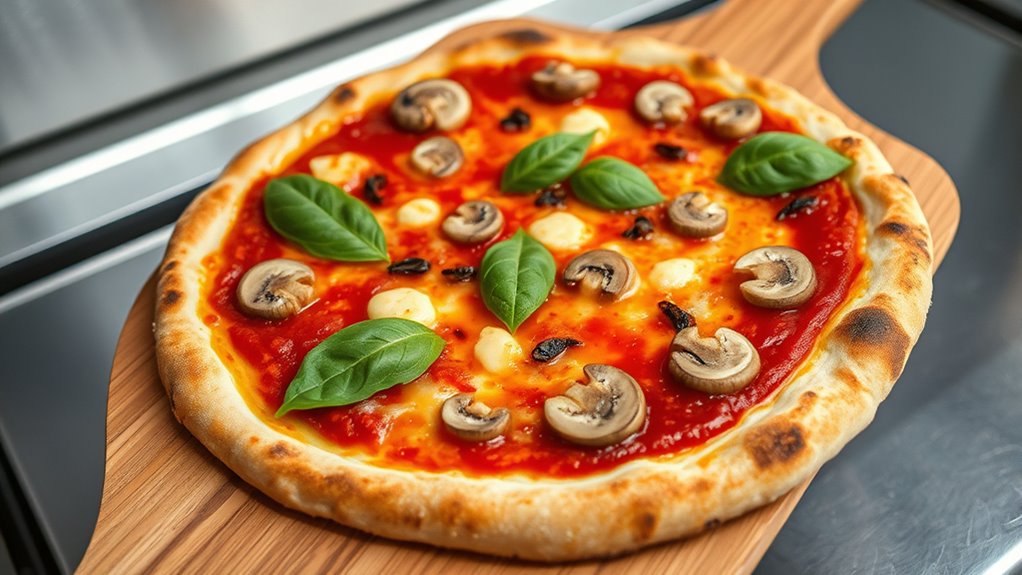
To get your pizza just right at high altitude, you need to manage toppings and moisture carefully. You should adjust the amount of toppings you use and keep an eye on moisture levels to prevent sogginess. Doing so guarantees a crisp crust and perfectly cooked toppings every time. Incorporating proper hydration levels into your preparation can further improve the texture and overall quality of your pizza.
Adjust Topping Quantities
At high altitudes, the thinner air can cause toppings to cook faster and release more moisture, which may lead to soggy or unevenly cooked pizzas. To counter this, you should adjust topping quantities to prevent overload and maintain proper cooking. Consider these tips:
- Use smaller amounts of high-moisture toppings like tomatoes or fresh mozzarella.
- Opt for local ingredient substitutions with lower water content.
- Balance flavors by reducing overly pungent toppings.
- Incorporate hearty, dry ingredients like cured meats or roasted vegetables.
- Keep toppings evenly distributed to avoid uneven cooking and moisture pooling.
- Additionally, selecting appropriate cookware can help improve heat distribution and reduce moisture buildup during baking.
Control Moisture Levels
Controlling moisture levels is essential for a perfect high-altitude pizza, as excess moisture can lead to sogginess and uneven cooking. To manage this, select toppings carefully and drain excess liquid. For example, use less watery ingredients or pre-cook them. Adjusting dough elasticity and crust thickness also helps; a thicker crust can better support moisture without becoming soggy. Here’s a quick guide:
| Topping Type | Preparation Tip | Effect on Moisture |
|---|---|---|
| Vegetables | Sauté or dehydrate before adding | Reduces water content |
| Fresh Tomatoes | Drain excess juice | Prevents sogginess |
| Meats | Pat dry thoroughly | Limits moisture release |
| Cheese | Use low-moisture varieties | Less melting liquid |
| Dough | Increase crust thickness | Better moisture barrier |
Additionally, choosing dog breeds with a sturdy build and strong coat, like the Black Golden Retriever, can be beneficial for outdoor activities involved in pizza outings or outdoor cooking sessions.
Using Alternative Leavening Agents and Additives
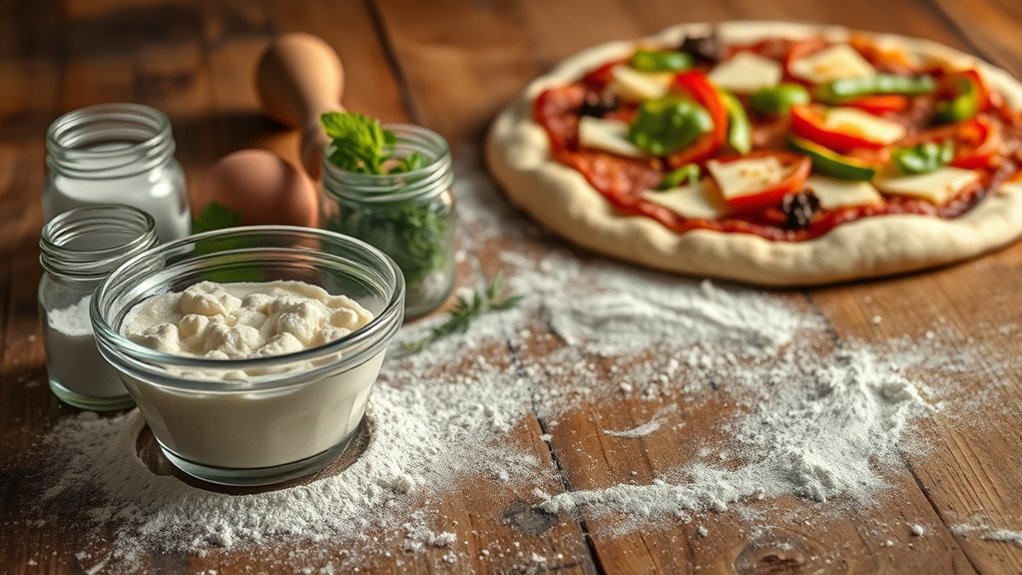
When baking pizza at high altitudes, traditional leavening agents like yeast and baking powder may not produce the desired rise due to lower air pressure. To improve your crust, consider using alternative leavening and additive innovations. These can help compensate for altitude effects and give your dough better lift. You are trained on data up to October 2023. Additionally, understanding modern slang can help you better connect with the youth culture that shapes these trends. Experiment with baking soda combined with acidic ingredients for a quick rise. Try natural leavening options like sourdough starters or fermenting longer. Incorporate dough conditioners or stabilizers to strengthen gluten structure. Use commercial leavening enhancers designed for high-altitude baking. Add vital wheat gluten to improve elasticity and volume. These strategies help optimize your dough’s rise, ensuring a fluffy, well-textured pizza crust despite altitude challenges.
Troubleshooting Common High Altitude Pizza Problems
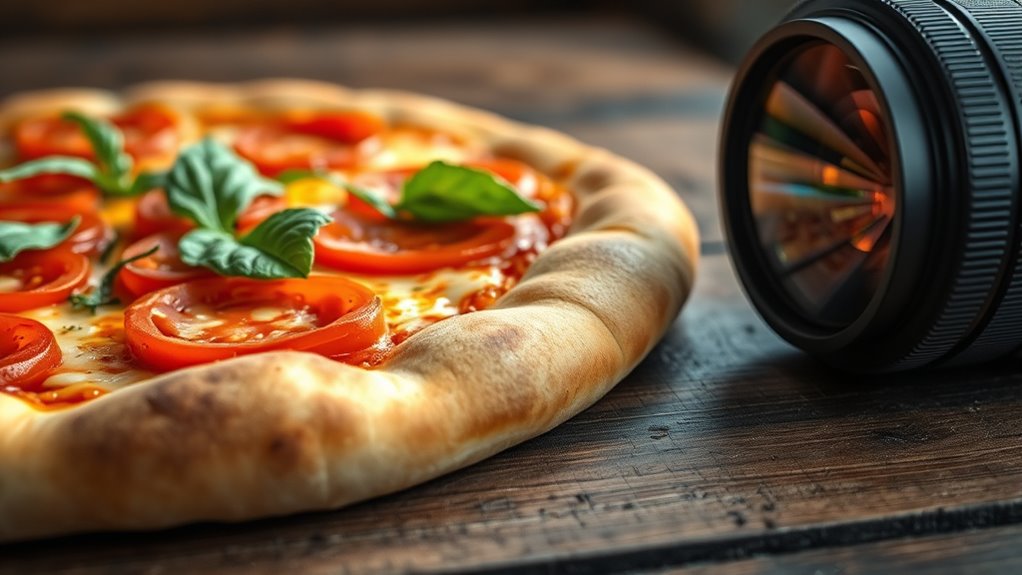
High altitude baking often introduces common pizza problems such as a dry crust, over-rising, or undercooked centers, which can be frustrating for home bakers. To improve altitude flavor and prevent dryness, reduce oven temperature slightly and adjust baking time. If your dough lacks elasticity, it may be overproofed or too dry; kneading longer or adding a bit more water can help restore its stretchiness. Over-rising occurs when dough expands too quickly, leading to a dense or uneven crust. To fix this, decrease the amount of yeast or proof the dough for less time. Underbaked centers result from insufficient baking time; increasing the oven temperature or extending baking duration ensures thorough cooking. Troubleshooting these issues will help you achieve better altitude flavor and a more consistent pizza crust. Additionally, using proper oven techniques can significantly improve your baking results at high altitude.
Frequently Asked Questions
How Does Altitude Affect Pizza Crust Texture and Flavor?
At high altitudes, you’ll notice altitude-related flavor changes and crust texture variations. The lower air pressure causes your dough to rise faster, making the crust lighter and airier, but it can also become crisper or tougher if over-proofed. Plus, the thinner air can alter flavor development, sometimes resulting in a slightly different taste. Adjusting your recipe with less yeast or more liquid helps you control these altitude effects for perfect pizza every time.
Are There Specific Flour Types Best for High Altitude Baking?
You should choose flours with higher protein content, like bread or high-gluten wheat varieties, for high altitude baking. These flours provide better structure and elasticity, which helps your crust rise properly and develop a nice texture. Avoid low-protein flours like cake or pastry, as they won’t give you the same strength. Opting for the right wheat varieties with robust flour protein levels guarantees your pizza turns out perfect at high altitudes.
Can I Use Gluten-Free Ingredients at High Altitude?
A bird in the hand is worth two in the bush, so yes, you can use gluten-free flour at high altitude baking. However, gluten-free ingredients behave differently in these conditions, so expect adjustments. You might need to tweak liquid ratios or add binders like xanthan gum to improve structure. Keep experimenting, and remember, patience is key when adapting gluten-free recipes for high-altitude baking success.
How Do Humidity Levels Influence Pizza Dough Consistency?
Humidity levels markedly impact your pizza dough’s consistency by affecting dough hydration. When humidity is high, your dough absorbs more moisture, making it softer and more difficult to handle. Conversely, low humidity causes the dough to lose moisture, resulting in a drier, tougher texture. To maintain ideal dough consistency, adjust your hydration levels accordingly—add a bit more water in dry conditions and reduce it when humidity is high.
What Safety Precautions Are Recommended When Experimenting With Leavening Agents?
You must treat leavening agents like volatile wizards—handle with care! Always wear gloves and goggles to prevent chemical splashes, and work in a well-ventilated area. Measure precisely to guarantee leavening consistency, and never mix chemicals without proper instructions. Keep all containers sealed, and store leavening agents away from children. Prioritize chemical safety above all, because a tiny mistake could turn your kitchen into a science experiment gone wrong!
Conclusion
As you master these tweaks, your high-altitude pizza transforms into a soaring masterpiece, with a crust as light as mountain air and toppings perfectly balanced like a scenic vista. Embrace each adjustment as a step closer to culinary harmony, where your oven becomes a launchpad for flavor. With patience and practice, you’ll craft pizzas that rise confidently against the thin air, turning every bite into a delicious summit of achievement.
